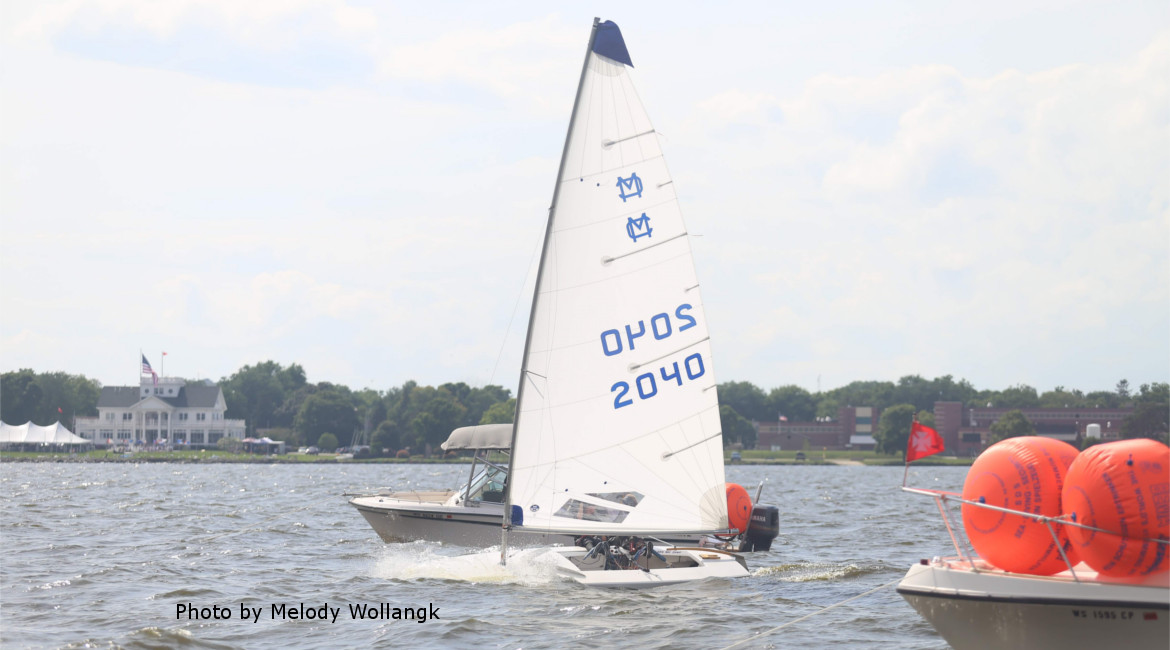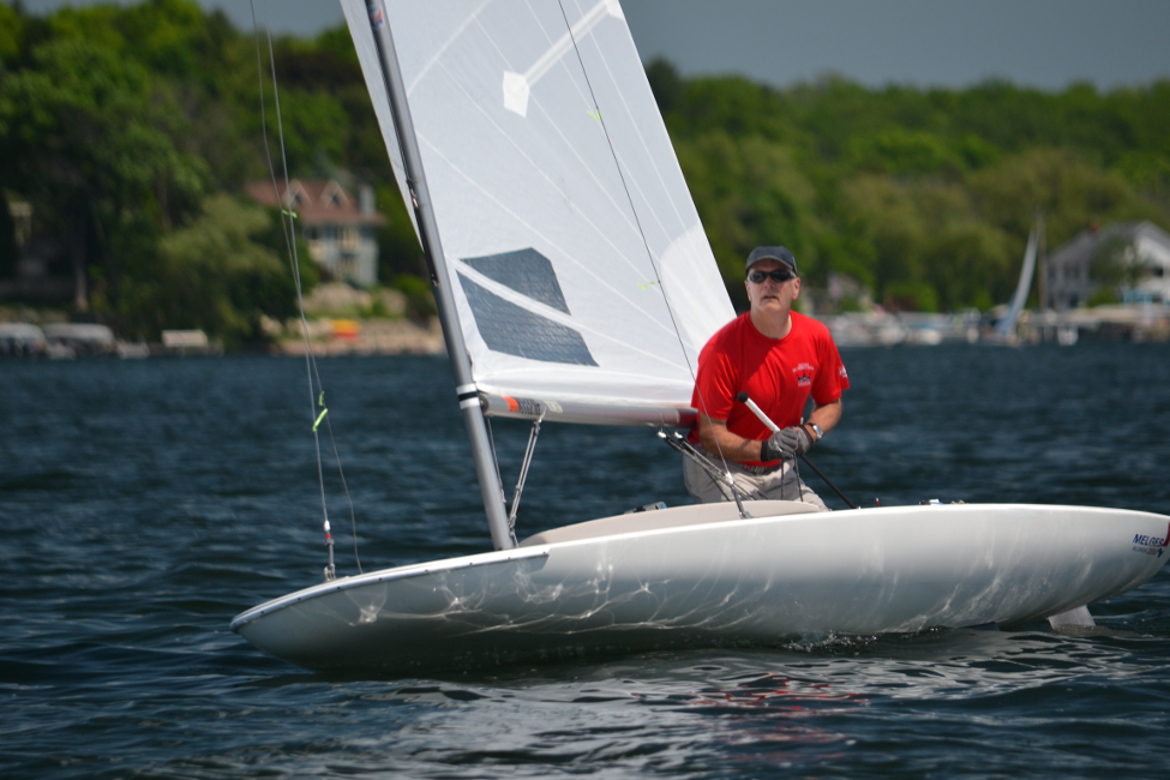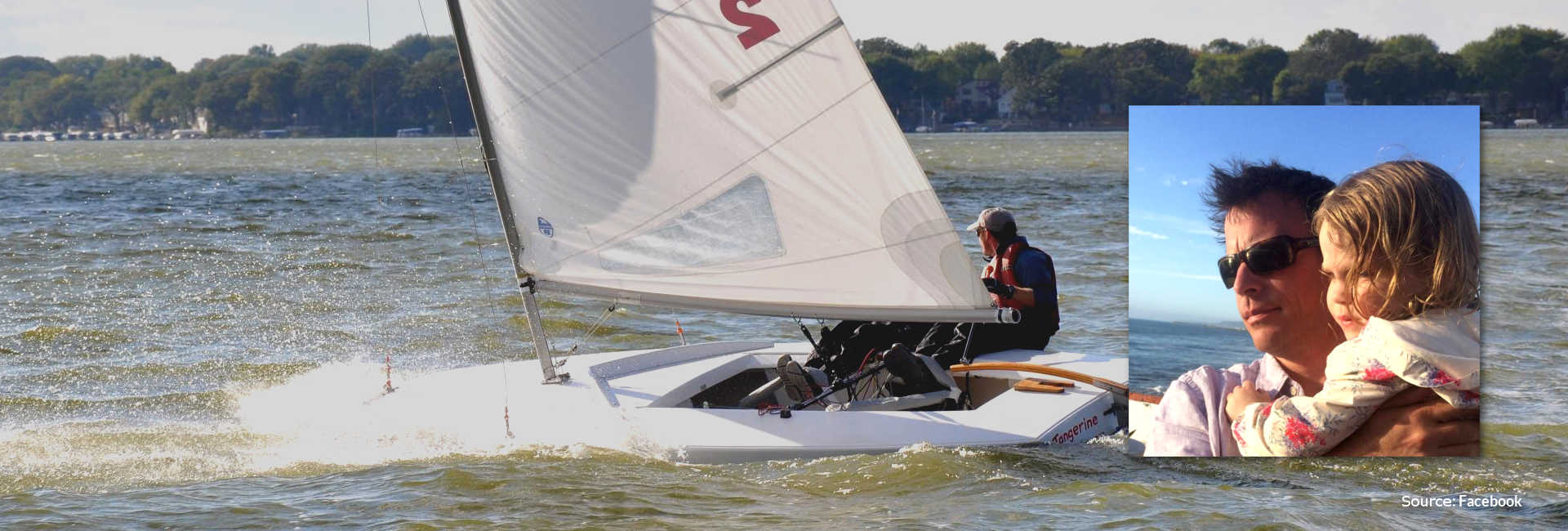Natalie Sinn, from Minnetonka Yacht Club, won the 2019 ILYA MC Scow Championship with crew Paige Packard. She is the first female to win the ILYA MC title. SailZing asked Natalie to share insights in this ILYA champion interview.
ILYA Champion Interview – MC Scows
Conditions on Winnebago
Question: Please talk about how you approached the specific conditions on Winnebago, which can be challenging for MCs.
Natalie: I have sailed on Winnebago once before, in a C boat, so I knew to come prepared for anything. The first day of racing was breezy, which my crew Paige and I typically prefer over the light air, as we enjoy sailing together. No one hikes harder than Paige!
In preparation for the bigger breeze and waves we actually reviewed a SailZing article about Downwind Trimming Strategies sent to us that morning by a fellow MYC sailor at the event.
In lighter air it was all about launching early and sailing around, testing my boat speed, angles, and practicing tacks and gybes. Even though the breeze died off for a while the last day, I believed it would fill in, and we would be racing. This kept me focused, confident, and prepared for when the breeze did a 180 and we were able to get some racing off.
Keys to Success
I feel what set us apart at the Inland was our boat speed, starts, and mark roundings. We managed to get off the line with pretty good starts, and always on the side of the line I wanted. The boat was moving fast in waves, as well as in light air. I made significant gains in some races by having a smooth wide, tight leeward mark rounding (whether in traffic on the outside, or with inside overlap).
It also helps a lot to be able to keep my head out of the boat and looking at the breeze and fleet around me. Sailing in the heavy air with a talented crew helps me stay aware of the fleet, as she can feed me information. Additionally, she works most of the controls and the boards so I can focus on tactics and boat handling.
Boat Speed
Question: Any favorite tips or techniques you use to keep the boat going fast?
Natalie: In the heavier air, especially in waves, we make sure our heel angle is as stable as possible (we keep it flatter in the bigger breeze). Upwind, we work the main sheet through the waves and puffs as needed to keep constant heel angle. We keep it flatter in the bigger breeze.
We also make sure the vang is not too tight through waves and lulls.
Steering through bigger breeze and waves takes a lot of practice. Thankfully I have a decent amount of practice in these conditions due to sailing on Lake Michigan in college on the 420, as well as on Lake Minnetonka. This came in handy as I transitioned into MC sailing.
In the lighter conditions, it is also about proper heel angle (not too flat and definitely not over heeled), proper main sheet trim (don’t over trim in the really light stuff).
I also think smooth boat handling in any wind conditions is of utmost importance. I make every effort to keep my boat handling smooth and stable for all maneuvers, and always match my sail trim with changes in steering.
If we have puffy conditions I probably work the vang and other controls more than the average person. Of course I am always watching for the pressure coming down the course, trying to keep myself positioned to stay in the best breeze as often as possible, and sailing the lifted tack.
Having a decent lane and clear air helps a lot in a bigger fleet. It helps to get off the starting line at full speed when the horn goes off. That’s all usually easier said than done, though.
First Beat
Question: How you plan the first beat – what side to go, etc.?
Natalie: Pre-start is pretty standard to what I believe most sailors do. I am checking the line to see if there is a favored side. We sail upwind off the line at various points and looking around to see my angle compared to the boats at other ends (would I be able to cross them?). I sail upwind and practice some tacks and try to get a sense if any tack is more lifted overall.
In the wavy conditions, there is usually a tack where the waves hit you at an angle that feels slower or they come over the bow more. I like to take note of that too. I keep an eye out for shifts and breeze coming down the lake.
Once I have an idea of what side has the best breeze, what side of the line may be favored, and which tack is favorable, I feel ready to choose my first beat strategy. Usually things go best if is stick to my original plan I have going into the start.
I may not always get a great start or have a solid lane. If this happens I may tack out for a better lane. Or, if I have someone bow out on me to leeward, I will drive down a bit and get a clear lane below them. This lets me avoid having to tack out if I feel I really want to stay on that side of the course.
Downwind in Waves
Question: How did you handle the waves downwind?
Natalie: When I’m sailing in wavy conditions downwind, I feel most comfortable and fast when I set the vang to match the wind conditions, and work the main sheet through the waves, coupled with steering. (See the above-referenced SailZing article.)
The downwind is a constant flow of pulling the main in as I head up a wave to keep the bow up, and surfing back down. I try to take advantage of one pump per wave if I can time it correctly.
If I am heading into a nose dive I may ease off the vang a bit to try to pop the bow up. However, if the breeze is heavy and too much vang comes off, it can force you into a cartwheel when the leech is too open! After having my first deathroll downwind a few weeks ago, I am a bit more cautious to keep the vang on pretty hard and use my steering and sail trim.
Sitting windward and heeling the boat to windward to drive the boat deeper seems to keep things flowing smoothly. If unstable I may drop a little more windward board. Additionally, if nose diving is an issue, I may have the crew sit across from me towards the stern to keep the bow up.
Related Content:
2019 ILYA Championship Results
Sailing Downwind in Waves – MC Scow
Get Your Head Out of the Boat!
Sailing with Crew in the MC Scow – Matt Fisher Comments





